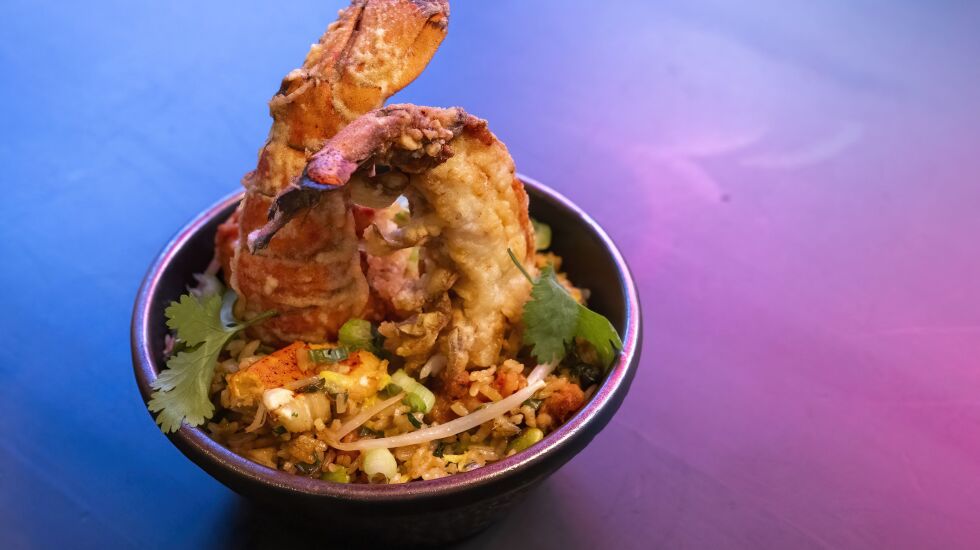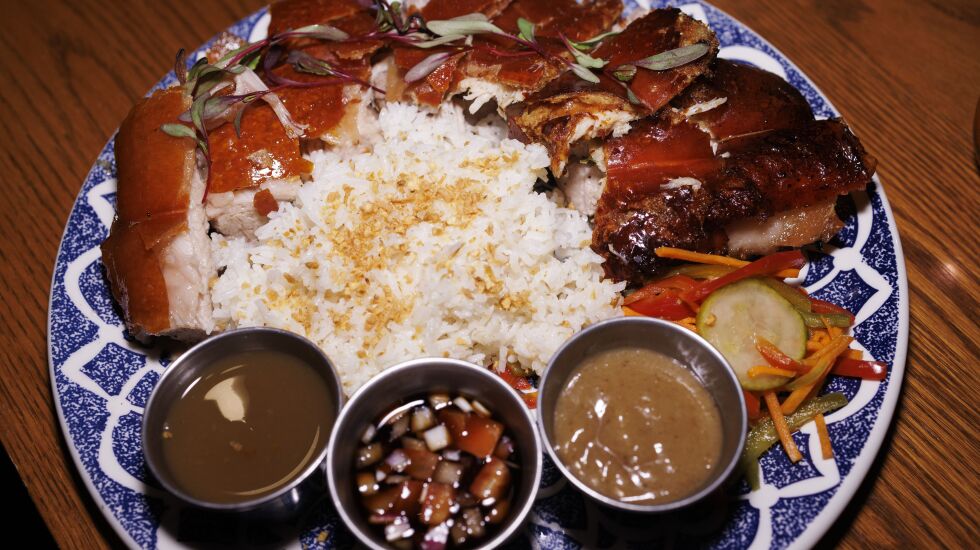
Filipino restaurants in the city are increasingly finding themselves in the national spotlight due to their creative takes on dishes inspired by the flavors of their childhood.
Kasama in East Village, where chefs Tim Flores and Genie Kwon have a tasting menu with elevated takes on traditional Filipino dishes, has garnered plenty of national acclaim with a James Beard award and Michelin star this year.
Another Filipino restaurant sharing the spotlight is Boonie’s Filipino Restaurant, 4337 N. Western Ave., which is a 2023 Michelin Bib Gourmand recipient.
Chef and owner Joe Fontelera, who went to Kendall College and worked at restaurants like Japonais by Morimoto, and Arami, where he worked as executive chef before focusing on Boonie’s, wants all the dishes at Boonie’s to be “identifiably Filipino, even if the presentations are not what you’re used to, but I still want someone to look at a very neat, clean, high-speed presentation and [say] ‘that’s Filipino food!’,” he said.
An example of this would be the kare kare, a rich stew typically made with peanut butter and oxtails with a spoonful or two of bagoong (fermented shrimp paste) to punctuate it with a salty note. Fontelera’s version swaps in the oxtails for braised beef tongue, soft and silky as butter left out at room temperature when you slice into it, with sunflower satti sauce and housemade bagoong (fermented shrimp paste) jam.

Filipino food — born of a country that is made of 7,000-plus islands — is hardly a monolith. A simple definition would be to call it “fusion” food due to the many influences from trade, colonization and occupation.
Dishes will vary from region to region; for example, adobo, a technique of braising food in vinegar, is largely considered the national dish of the Philippines but differs wildly depending on where you are in the country and even whose home you’re in. Some places use soy sauce; others do not. Some use chicken, pork, a mixture of both or neither (especially in the south where many Filipinos are Muslim and do not eat pork).
When it comes to Filipino food in the city, Fontelera said, “I feel like the bar definitely is getting a little bit higher, which I like. And I think that we’re just going to see more. I think we’re gonna see more representation from everybody.”

Lawrence Letrero, chef of Bayan Ko, which he owns with his wife Raquel Quadreny, said a generation of chefs like himself and Fontelera honed their skills in other restaurants before opening their own Filipino restaurants in the city.
“The food was always excellent,” Letrero said. “There were just a few of us Filipinos that were going to culinary school who were a little younger, and we now have matured and have worked for other great restaurant groups. … Now we can spread our wings and say, ‘Hey, we’re Filipinos. We’re gonna do Filipino food.’”

Letrero moved to Chicago in 2006 to go to culinary school and worked at restaurants like Perennial and Sable Kitchen and Bar before opening Bayan Ko, 1810 W. Montrose Ave., five years ago.
When he and Quadreny started dating, they would cook for each other, with Filipino and Cuban dishes sharing space on the table. They realized their food shared a lot of similarities such as ropa vieja, a stew with shredded beef, onions, peppers, olives and tomato sauce, much of which is also present in Filipino mechado.
The lobster fried rice served at the restaurant is an example of a dish that’s a nod to both Cuban and Filipino cultures.
“Cubans love fried rice. You go to a Cuban restaurant and it’s called arroz Chino. Then obviously Filipinos love fried rice, too,” Letrero said.
Bayan Ko’s version features tempura fried lobster tails on top of rice accentuated with longganisa (Filipino sausage), edamame, scrambled eggs and soy sesame butter.

Bayan Ko reinterprets the classic bar food sisig, but instead of a large plate, Letrero makes it nigiri-style with pork belly and ear, black vinegar and quail eggs on top of sushi rice with a layer of nori.

Mano Modern Cafe, 851 N. Ashland Ave., also takes dishes that diners are familiar with and reimagines them with Filipino flair.
The best seller is breakfast, anchored by silogs, which are rice dishes with eggs and a choice between Spam, longganisa and tocino bacon, a Mano specialty. Tocino is typically pork cured with a mixture of sugar, salt and annatto powder, and Mano puts its own twist on the breakfast meat by putting those seasonings on bacon so it gets a sweet, caramelized coating. The tocino bacon also makes an appearance on Mano’s cheeseburger.

Melvin Reyes, a chef from Cleveland who owns a Filipino restaurant with his brother and two cousins, oversees the food at Mano. He and Mano majority partner Zandro Zafra have big plans to expand the Mano concept in the Midwest.
“I want to put Filipino food on the map that’s accessible, higher quality, and pretty much dominate the Midwest. The plan is to have between 30 to 100 [restaurants] within the next five years,” Reyes said.

Zafra ran Ctrl Z Coffee in Washington Park last year featuring Filipino coffee drinks like ube lattes. What the cafe didn’t have was Filipino food, giving him the idea to pair high-quality coffee drinks with equally high-quality fast Filipino food in a sit-down environment.
The ube (purple yam), pandan and White Rabbit (a creamy milk candy that is a nostalgic treat for many Filipinos) are made in house, Zafra said.
“People of our generation just want to have food that we normally eat, and remind us of our childhood and remind us of home,” said the 32-year-old.

Another restaurant inspired by home is Cebu, founded by a group of siblings who hail from the island of the same name in the Philippines.
Cebu’s cuisine has a lot of Chinese and Spanish influences, the latter especially prominent as it was the first island colonized in the country by the Spanish. Cebu the island is known for its lechon, pork usually slow roasted on a spit. At the restaurant, pork belly is seasoned with onion, garlic, lemon grass, star anise and a signature rub, then roasted and basted for three hours to ensure a perfectly crispy skin.

Another signature dish is gambas, shrimp sauteed in garlic and seasoned with banana ketchup, a Filipino staple, and oyster sauce.
“It’s a Spanish dish with Asian flavors,” said Marlon Tan, one of the partners.

His brother, Malvin, is the chef who draws on his knowledge of French technique to tweak dishes while staying true to the flavor of the original dish, like kinilaw, which is fish that has been “cooked” by acid, usually vinegar, and mixed with red onion and chiles. At Cebu, the dish is elevated with coconut-ginger espuma (the Spanish term for foam), bourbon barrel smoked trout roe and shio kombu.

Cocktails are also carefully constructed, such as the Smokin’ Cebu Later with La Luna Mezcal, tamarindo, Nixta Elote Calamansi and tonic water that is smoked.
Cebu is closing its Wicker Park location in December and reopening early next year to Lakeview in a larger space, allowing it to be even more creative with food and cocktails as well as add brunch, Tan said.
“The sky’s the limit in what Filipino cuisine could be in Chicago and hopefully ... Chicago will be well known for Filipino food in the U.S.,” Tan said.
“It’s a good future ahead.”








